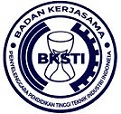Perilaku Evakuasi Bencana dengan Pendekatan Simulasi: Studi Literatur
Abstract
ABSTRAK
Salah satu isu penting dalam kesiapsiagaan bencana adalah pada perencanaan evakuasi yang tepat. Evakuasi menjadi faktor penting dalam mengurangi risiko bencana. Adapun pendekatan yang sering dilakukan untuk menjelaskan perilaku evakuasi adalah dengan menggunakan pendekatan simulasi. Namun dari studi literatur ditemukan masih minim pembahasan mengenai simulasi pada perilaku evakuasi bencana secara vertical maupun horizontal dan moda transportasi yang tepat. Tujuan dari penelitian ini adalah memaparkan literatur evakuasi bencana dengan pendekatan simulasi dan berbagai moda transportasi yang menjadi pilihan. Metode yang digunakan pada penelitian adalah studi literatur secara sistematis pada naskah jurnal terindeks googlescholar, Scopus, Web of Science yang dipublikasikan dari tahun 2015 sampai dengan 2021, dengan kata kunci behavioural, evacuation, simulation dan modelling. Hasil dari penelitian ini adalah berbagai pendekatan simulasi dipilih dalam mengevaluasi perilaku evakuasi karena dinilai sebagai metode pendekatan yang sesuai. Sedangkan moda transportasi yang sesuai dapat berdampak pada efektivitas evakuasi. Adapun metode evakuasi dapat berupa evakuasi horizontal maupun vertikal.
Kata Kunci: Bencana, Perilaku evakuasi, Simulasi, Studi Literatur
ABSTRACT
Readiness in catastrophe is the one of critical issues in evacuation planning. The evacuation becomes success factor in reducing the number of victims. The simulation is frequently applied to interpret behavioural evacuation and to evaluate the evacuation effectiveness. Nevertheless, only few literatures discuss about how simulation approach in behavioural vertical or horizontal evacuation, and transportation mode. The objective of this paper is to review literature that discuss about simulation approach in behavioural evacuation and also choosing the transportation modes. Systematic literature review is applied method and it is done for manuscripts published in 2015-2021 indexed by Google scholar, Scopus, and Web of Science. The key words are behavioural, evacuation, simulation and modelling. The result is simulation approach is appropriate method for analysing behavioural evacuation in various natural disasters. Furthermore, the choosing of transportation modes might effect on evacuation effectiveness. And also there are two evacuation methods; horizontal and vertical evacuation.
Keyword: Behavioural evacuation, Catastrophe, Simulation, Literature Review
Full Text:
PDFReferences
Adam, Carole, and Benoit Gaudou. 2017. “Modelling Human Behaviours in Disasters from Interviews: Application to Melbourne Bushfires.” Journal of Artifiicial Societies and Social Simulation 20(3): 1–17.
Aguilar, Leonel et al. 2019. “Mass Evacuation Simulation Considering Detailed Models: Behavioral Profiles, Environmental Effects, and Mixed-Mode Evacuation.” Asia Pacific Management Review 24(2): 114–23. https://doi.org/10.1016/j.apmrv.2019.05.001.
Amri, M.R et al. 2016. Direktort Pengurangan Resiko Bencana Deputi Bidang Pencegahan dan Kesiapansiagaan Risiko Bencana Indonesia. Jakarta.
Aydin, Nezir. 2020. “Designing Reverse Logistics Network of End-of-Life-Buildings as Preparedness to Disasters under Uncertainty.” Journal of Cleaner Production 256: 1–11. https://doi.org/10.1016/j.jclepro.2020.120341.
Bernardini, Gabriele, Enrico Quagliarini, Marco D’Orazio, and Maurizio Brocchini. 2020. “Towards the Simulation of Flood Evacuation in Urban Scenarios: Experiments to Estimate Human Motion Speed in Floodwaters.” Safety Science 123(April 2019): 104563. https://doi.org/10.1016/j.ssci.2019.104563.
Calumba, Sherwin Roy, Monorom Rith, and Alexis M. Fillone. 2021. “Earthquake Evacuation Choice and Management in a Developing Archipelagic Country—a Case Study of Surigao City, Philippines.” Sustainability (Switzerland) 13(11): 2–24.
Cimellaro, G.P et al. 2017. “Simulating Earthquake Evacuation Using Human Behavioral Models.” Earthquake Engineering & Structural Dynamics2. http://www.stanford.edu/~bakerjw/Publications/Baker (2007) Record scaling, 8PCEE.pdf%5Cnpapers2://publication/uuid/1498A307-A88B-4AAF-B3F7-E6B4B14F87C2.
Cimellaro, Gian Paolo, Stephen Mahin, and Marco Domaneschi. 2019. “Integrating a Human Behavior Model within an Agent-Based Approach for Blasting Evacuation.” 34: 3–20.
Hong, Lingzi, and Vanessa Frias-Martinez. 2020. “Modeling and Predicting Evacuation Flows during Hurricane Irma.” EPJ Data Science 9(1). http://dx.doi.org/10.1140/epjds/s13688-020-00247-6.
Jumadi, Steve Carver, and Duncan Quincey. 2016. “A Conceptual Framework of Volcanic Evacuation Simulation of Merapi Using Agent-Based Model and GIS.” In Procedia - Social and Behavioral Sciences, The Author(s), 402–9. http://dx.doi.org/10.1016/j.sbspro.2016.06.092.
Kasereka, Selain et al. 2018. “Agent-Based Modelling and Simulation for Evacuation of People from a Building in Case of Fire.” Procedia Computer Science 130: 10–17. https://doi.org/10.1016/j.procs.2018.04.006.
Lee, Jooyong, and Kara M. Kockelman. 2021. “Strategic Evacuation for Hurricanes and Regional Events with and without Autonomous Vehicles.” Transportation Research Record: Journal of the Transportation Research Board: 036119812110074.
Lee, Seunghan, Saurabh Jain, Keeli Ginsbach, and Young Jun Son. 2021. “Dynamic-Data-Driven Agent-Based Modeling for the Prediction of Evacuation Behavior during Hurricanes.” Simulation Modelling Practice and Theory 106(August 2020): 102193. https://doi.org/10.1016/j.simpat.2020.102193.
Li, Lei et al. 2017. “Agent-Based Simulation of Evacuation Considering Extreme Weather in Tourist Areas.” In Proceedings - 13th International Conference on Computational Intelligence and Security, CIS 2017, , 431–34.
Lovreglio, Ruggiero. 2020. “Virtual and Augmented Reality for Human Behaviour in Disasters: A Review Emergency Evacuation.” In Fire Evacuation Modeling Technical Conference (FEMTC), , 1–14. https://www.researchgate.net/publication/343809101.
Lu, Xinzheng, Zhebiao Yang, Gian Paol Cimellaro, and Zhen Xu. 2019. “Pedestrian Evacuation Simulation under the Scenario with Earthquake- Induced Falling Debris.” Safety Science 114(October 2018): 61–71. https://doi.org/10.1016/j.ssci.2018.12.028.
Meechang, Kunruthai et al. 2020. “The Acceptance of Using Information Technology for Disaster Risk Management: A Systematic Review.” Engineering Journal 24(4): 111–32.
Mehmood, Saqib, Shakeel Ahmed, and Anders Schmidt Kristensen. 2019. “Application of Integrated Model of Evacuation Psychology in an Agent-Based Simulation.” In ACM International Conference Proceeding Series, , 70–74.
Mostafizi, Alireza et al. 2017. “Agent-Based Tsunami Evacuation Modeling of Unplanned Network Disruptions for Evidence-Driven Resource Allocation and Retrofitting Strategies.” Natural Hazards 88(3): 1347–72.
Mostafizi, Alireza, Haizhong Wang, Dan Cox, and Shangjia Dong. 2019. “An Agent-Based Vertical Evacuation Model for a near-Field Tsunami: Choice Behavior, Logical Shelter Locations, and Life Safety.” International Journal of Disaster Risk Reduction 34(August 2018): 467–79.
Nakanishi, Hitomi, John Black, and Yoshihiro Suenaga. 2019. “Investigating the Flood Evacuation Behaviour of Older People: A Case Study of a Rural Town in Japan.” Research in Transportation Business and Management 30(February): 100376. https://doi.org/10.1016/j.rtbm.2019.100376.
Robinson, R. Michael et al. 2018. “Modeling the Impact of Traffic Incidents during Hurricane Evacuations Using a Large Scale Microsimulation.” International Journal of Disaster Risk Reduction 31(September): 1159–65. http://dx.doi.org/10.1016/j.ijdrr.2017.09.013.
Sadri, Arif Mohaimin, Satish V. Ukkusuri, Pamela Murray-Tuite, and Hugh Gladwin. 2015. “Hurricane Evacuation Route Choice of Major Bridges in Miami Beach, Florida.” Transportation Research Record 2532: 164–73.
Shimamoto, Hiroshi et al. 2017. “Evaluation of Tsunami Evacuation Planning Considering Vehicle Usage and Start Timing of Evacuation.” Transportmetrica A: Transport Science 14: 1–16.
Shirvani, Mohammad, Georges Kesserwani, and Paul Richmond. 2021. “Agent-Based Simulator of Dynamic Flood-People Interactions.” Journal of Flood Risk Management 14(2): 1–17.
Shuto, N. 2015. “Tsunamis: Their Coastal Effects and De- Fense Works.” In Scientific Forum on Tsunami, Its Impact and Recovery, 1-12, Thailand: Asian Institute of Technology, 1–12.
Sonohara, Makoto, Kohei Sakai, Masakazu Takahshi, and Toshiyuki Kaneda. 2018. “A Study on Agent Modeling of Tourist Evacuation Behaviors in an Earthquake: A Case Study of an Evacuation Simulation of Himeji Castle.” In Innovative Approaches in Agent-Based Modelling and Business Intelligence, , 189–204.
Takabatake, Tomoyuki, Kota Fujisawa, Miguel Esteban, and Tomoya Shibayama. 2020. “Simulated Effectiveness of a Car Evacuation from a Tsunami.” International Journal of Disaster Risk Reduction. https://doi.org/10.1016/j.ijdrr.2020.101532.
Ukkusuri, Satish V. et al. 2017. “A-RESCUE: An Agent Based Regional Evacuation Simulator Coupled with User Enriched Behavior.” Networks and Spatial Economics 17(1): 197–223. http://dx.doi.org/10.1007/s11067-016-9323-0.
Usman, Fadly, Keisuke Murakami, Agus Dwi Wicaksono, and Eko Setiawan. 2017. “Application of Agent-Based Model Simulation for Tsunami Evacuation in Pacitan, Indonesia.” In MATEC Web of Conferences, , 2–16.
Wang, Haizhong et al. 2016. “An Agent-Based Model of A Multimodal Near-Field Tsunami Evacuation: Decision-Making and Life Safety.” Transportation Research Part C: Emerging Technologies 64: 86–100. http://dx.doi.org/10.1016/j.trc.2015.11.010.
Wang, Jiyun, Xiaoyang Yu, and Ruowen Zong. 2020. “A Dynamic Approach for Evaluating the Consequences of Toxic Gas Dispersion in the Chemical Plants Using CFD and Evacuation Modelling.” Journal of Loss Prevention in the Process Industries 65(May): 104–56. https://doi.org/10.1016/j.jlp.2020.104156.
Wei, Xiaowen et al. 2020. “An Integrated Location-Routing Problem with Post-Disaster Relief Distribution.” Computers and Industrial Engineering 147: 106–632. https://doi.org/10.1016/j.cie.2020.106632.
Yang, Hong, Ender Faruk Morgul, Kaan Ozbay, and Kun Xie. 2016. “Modeling Evacuation Behavior Under Hurricane Conditions.” Transportation Research Record: Journal of the Transportation Research Board 2599(1): 63–69.
Yang, Kun et al. 2019. “Incorporating Inland Flooding into Hurricane Evacuation Decision Support Modeling.” Natural Hazards 96(2): 857–78. https://doi.org/10.1007/s11069-019-03573-9.
Yao, Yishu, and Wei Lu. 2020. “Research on Kindergarten Children Evacuation: Analysis of Characteristics of the Movement Behaviours on Stairway.” International Journal of Disaster Risk Reduction 50(November 2019): 101–718. https://doi.org/10.1016/j.ijdrr.2020.101718.
Yoshikawa, Tadahiro. 2015. “Research on Planning Process of Community Disaster Management Plan at Tsunami-Hit Area.” Journal of Disaster Research 10: 736–54.
Zhu, Yuan, Kun Xie, Kaan Ozbay, and Hong Yang. 2018. “Hurricane Evacuation Modeling Using Behavior Models and Scenario-Driven Agent-Based Simulations.” Procedia Computer Science 130: 836–43. https://doi.org/10.1016/j.procs.2018.04.074.
DOI: http://dx.doi.org/10.24014/jti.v7i2.14157
Refbacks
- There are currently no refbacks.
Copyright (c) 2021 Mohamad Jihan Shofa

This work is licensed under a Creative Commons Attribution-NonCommercial-ShareAlike 4.0 International License.
Jurnal Teknik Industri
P-ISSN 2460-898X | E-ISSN 2714-6235
Published by:
Industrial Engineering Department
Universitas Islam Negeri Sultan Syarif Kasim Riau, Indonesia
Office Address:
H.R. Soebrantas KM 15.5, Tampan, Pekanbaru, Riau, Indonesia 28293
email: jti.fst@uin-suska.ac.id
Indexed by:
JTI : Jurnal Teknik Industri under a Creative Commons Attribution-NonCommercial-ShareAlike 4.0 International License.

















